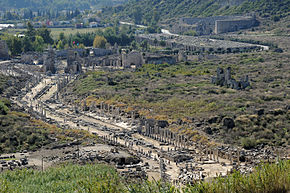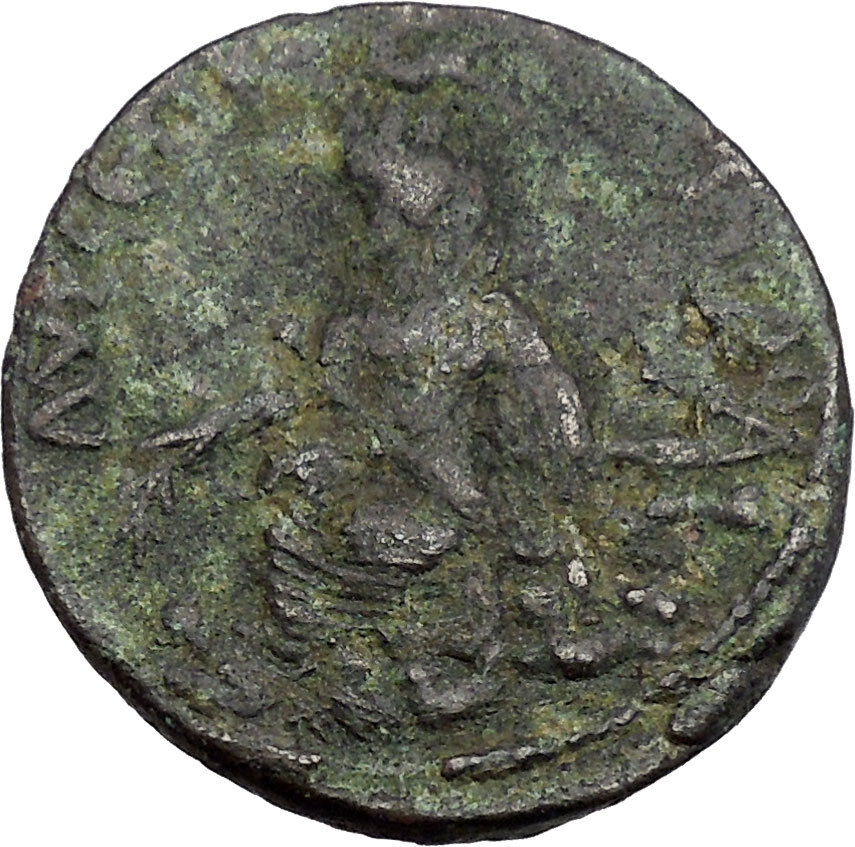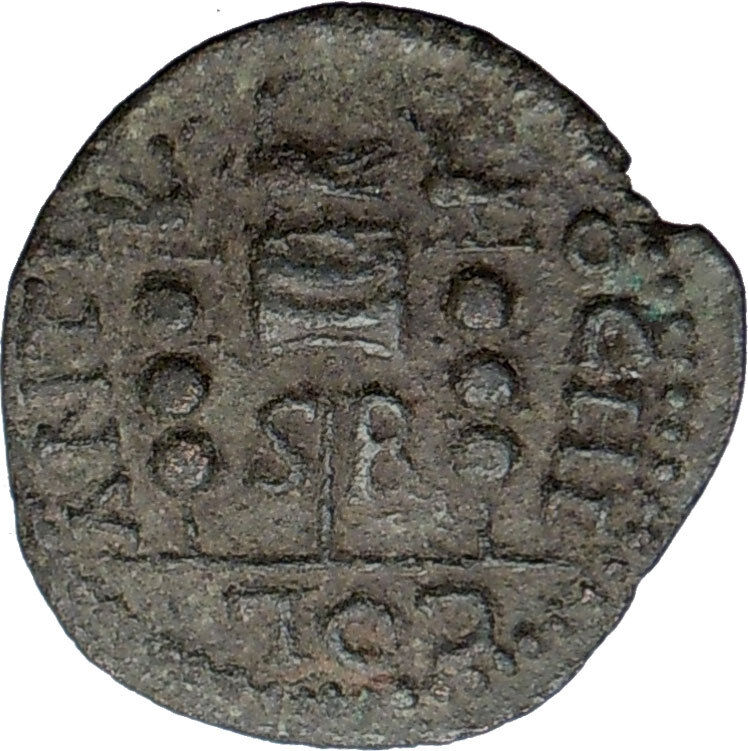|
Philip II – Caesar: 244-247 & Roman Emperor: 247-249 A.D.
Bronze 22mm (7.25 grams) of Perga in Pamphylia
Reference: SNG von Aulock 470; SNG France 511ff..
AV K M IOV CЄOV ΦIΛIΠΠOC, laureate, draped and cuirassed bust of Philip II right; beneath, small globe.
ΠЄΡ – ΓAI – ΩN, ethnic aaround three sides of four-legged chest with folding doors, atop which, three prize purses are set.
You are bidding on the exact item pictured, provided with a Certificate of Authenticity and Lifetime Guarantee of Authenticity.
Perga or Perge (Greek: Πέργη Perge, Turkish: Perge) was an ancient Anatolian city in modern Turkey, once the capital of Pamphylia Secunda, now in Antalya province on the southwestern Mediterranean coast of Turkey. Today, it is a large site of ancient ruins 15 kilometres (9.3 mi) east of Antalya on the coastal plain. An acropolis located there dates back to the Bronze Age.

Overview of Perga
History
Perga was an ancient and important city of Pamphylia, between the rivers Catarrhactes and Cestrus (Turkish Aksu Çayı).
A treaty between the Hittite Great King Tudhaliya IV and his vassal, the king of Tarhuntassa, defined the latter’s western border at the city “Parha” and the “Kastaraya River”. The river is assumed to be the classical Cestrus. West of Parha were the “Lukka Lands”. Parha likely spoke a late Luwian dialect like Lycian and that of the neo-Hittite kingdoms.
Perge returns to history as a Pamphylian Greek city, and with Pamphylia came under successive rule by Persians, Athenians, and Persians again. Alexander the Great, after quitting Phaselis, occupied Perge with a part of his army. The road between these two towns is described as long and difficult. Alexander’s rule was followed by the Diadochi empire of the Seleucids, then the Romans.
Perge gained renown for the worship of Artemis, whose temple stood on a hill outside the town, and in whose honour annual festivals were celebrated. The coins of Perge represent both the goddess and her temple.
In 46 A.D., according to the Acts of the Apostles, St. Paul journeyed to Perga, from there continued on to Antiocheia in Pisidia, then returned to Perga where he preached the word of God (Acts 14:25). Then he left the city and went to Attaleia.
As the Cestrus silted up over the late Roman era, Perga declined as a secular city. In the first half of the 4th century, during the reign of Constantine the Great (324-337), Perga became an important centre of Christianity, which soon became the official religion of the Roman Empire. The city retained its status as a Christian centre in the 5th and 6th centuries.
 The agora The agora The stadium The stadium
Ecclesiastical history
St. Paul the Apostle and his, companion St. Barnabas, twice visited Perga as recorded in the biblical book, the Acts of the Apostles, during their first missionary journey, where they “preached the word” before heading for and sailing from Attalia (modern-day Antalya city), 15 kilometres (9.3 mi) to the southwest, to Antioch.
Paul and Barnabas came to Perge during their first missionary journey, but probably stayed there only a short time, and do not seem to have preached there; it was there that John Mark left Paul to return to Jerusalem. On his return from Pisidia, Paul preached at Perge.
St. Matrona of Perge of the 6th century was a female saint known for temporarily cross-dressing to avoid her abusive husband. She also is known for opposing the Monophysite policy of the emperor Anastasios I. Matrona hid in the monastery of St. Bassion as the enuch Babylos. Once revealed, she was sent to a woman’s monastery where she was head of the convent. She was famous for her miraculous gift of healing. She went on to found a nunnery in Constantipole. St Matrona died at the age of 100. Her life was told through a vita prima whose author and exact time period remains a mystery.
The Greek Notitiae episcopatuum mentions the city as metropolis of Pamphylia Secunda until the 13th century. Le Quien gives the names of 11 of its bishops: Epidaurus, present at the Council of Ancyra in 312; Callicles at the First Council of Nicaea in 325; Berenianus, at Constantinople (426); Epiphanius at the Second Council of Ephesus (449), at the First Council of Chalcedon (451), and a signatory of the letter from the bishops of the province to Emperor Leo (458); Hilarianus, at a council at Constantinople in 536; Eulogius, at the Second Council of Constantinople in 553; Apergius, condemned as a Monothelite at the Third Council of Constantinople in 680; John, at the Trullan council in 692; Sisinnius Pastillas about 754 (an iconoclast who was condemned at the Second Council of Nicaea in 787); Constans, at the same council of that condemned his predecessor; John, at the Council of Constantinople of 869-70.
No longer a residential, the bishopric is included in the Catholic Church’s list of titular sees.
Perga remained inhabited until the Seljuks.
Remains
Perga is today an archaeological site and a tourist attraction. Ancient Perge, one of the chief cities of Pamphylia, was situated between the Rivers Catarrhactes (Düden Nehri) and Cestrus (Aksu), 60 stadia (about 11.1 kilometres (6.9 mi)) from the mouth of the latter; the site is in the modern Turkish village of Murtana on the Suridjik sou, a tributary of the Cestrus, formerly in the Ottoman vilayet of Konya. Its ruins include a theatre, a palaestra, a temple of Artemis and two churches. The temple of Artemis was located outside the town.
Another big ancient city in the area is Selge, Pisidia, located about 20km to the northeast.
Notables
- Perga’s most celebrated ancient inhabitant, the mathematician Apollonius (c.262 BC – c.190 BC), lived and worked there. He wrote a series of eight books describing a family of curves known as conic sections, comprising the circle, ellipse, parabola, and hyperbola.
 Pillars of the agora Pillars of the agora Roman theatre Roman theatre Palaestra in front of the Roman baths Palaestra in front of the Roman baths Caldarium in the Roman baths Caldarium in the Roman baths Hellenistic city gate Hellenistic city gate Nymphaeum Nymphaeum
 Philip II – 247-249 A.D. Philip II – 247-249 A.D.
Caesar: 244-247 A.D. (under Philip I) | Augustus: 247-249 A.D. (with Philip I)
Son of Philip I ‘The Arab’ and Otacilia Severa | Grandson of Julius Marinus
Marcus Julius Philippus Severus, also known as Philippus II, Philip II and Philip the Younger (238-249) was the son and heir of the Roman Emperor Philip the Arab by his wife Roman Empress Marcia Otacilia Severa. According to numismatic evidence, he had a sister called Julia Severa or Severina, whom the ancient Roman sources do not mention.
When his father became emperor in 244 he was appointed Caesar. Philippus was consul in 247 and 248. His father was killed in battle by his successor Decius in 249. When news of this death reached Rome, he was murdered by the Praetorian Guard. He died in his mother’s arms. When he died, he was eleven years old.
|






 The agora
The agora The stadium
The stadium Pillars of the agora
Pillars of the agora Roman theatre
Roman theatre Palaestra in front of the Roman baths
Palaestra in front of the Roman baths Caldarium in the Roman baths
Caldarium in the Roman baths Hellenistic city gate
Hellenistic city gate Nymphaeum
Nymphaeum Philip II – 247-249 A.D.
Philip II – 247-249 A.D.




